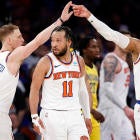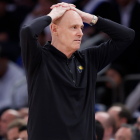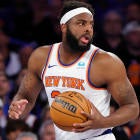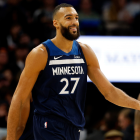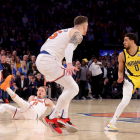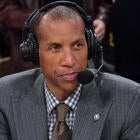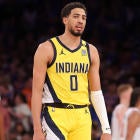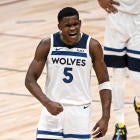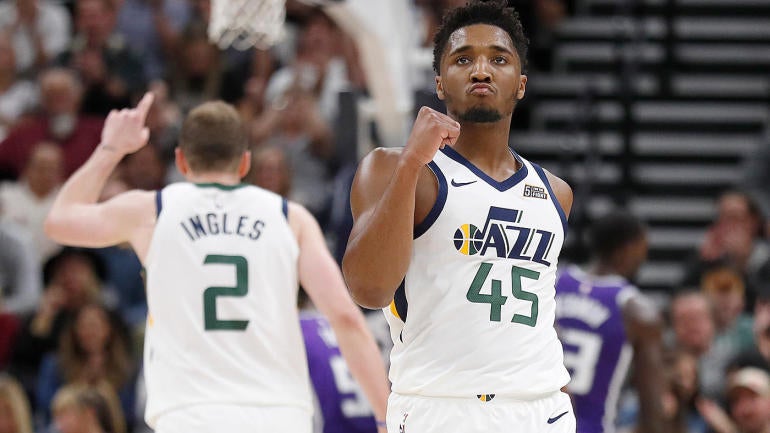
If you told any Utah Jazz fan that they would be 28-12 and tied for the Western Conference's No. 2 seed through 40 games, they'd probably shrug and say something along the lines of "yeah, that sounds about right." The Jazz wound up just about where the world expected them to be. It's how they got there that is so interesting.
Utah's season didn't truly begin until Mike Conley got hurt. The Jazz started 12-9 with him on the floor and have since gone 16-3 without him. Their offense was ranked 23rd before his injury and is ranked third ever since. The truth probably lies somewhere in between, but until Conley returns to the floor and starts to answer the many questions his underwhelming Utah debut raised, virtually everything the Jazz do will revolve around him in some way. So naturally, the only place to start in grading their season to date is with the trade itself.
The Mike Conley trade: D
The suggestion that all Utah needed to unlock this juggernaut was Conley's injury is a bit unfair. The Jazz ran out a starting lineup of Conley, Donovan Mitchell, Bojan Bogdanovic, Royce O'Neale and Rudy Gobert in 18 games, and that fivesome absolutely decimated opponents by 17.2 points per 100 possessions. The schedule got easier. Players league-wide suffered slow starts, thanks to the wear and tear of the FIBA World Cup, and arguably Utah's four most important players all suited up in China. What is currently happening to the Jazz isn't as simple as "the right player got hurt."
But Conley was undoubtedly worse for Utah than he ever was for Memphis. His shooting numbers plummeted in virtually every area of the court.
| Conley Shooting Stats | 2018-19 | 2019-20 |
|---|---|---|
0-3 FT FG% | 55.4 | 48.6 |
3-10 FT FG% | 49.4 | 34.4 |
10-16 FT FG% | 42.9 | 34.1 |
16-3PT line FG% | 42.3 | 29.4 |
3PT% | 36.4 | 36.0 |
A clear athletic decline explains some of this. A younger Conley was willing to attack the basket with reckless abandon when necessary, but less than 13 percent of his shot attempts have come within three feet of the basket this season. The old Conley could have made up for that with his killer floater, but it hasn't fallen this season as he's adjusted to sharing the ball and playing with a very different sort of center. For a decade, Conley shared a peerless two-man dance with Marc Gasol, one of the NBA's best passing big man and a center who could draw defenses out of the paint. Rudy Gobert doesn't do those things.
Giving the trade an "F" implies that it's already a failure. In truth, there are ways this can be turned around. It's just looking bleak, and its success or failure is going to be tied to several of the categories listed below.
Team defense: B-
Death, taxes and a dominant Utah defense. Those have been life's three certainties since Rudy Gobert was drafted. The Jazz have had a top-three defense for the past three seasons. They were seventh during his first year as a full-time starter only because he missed 21 games. They were No. 1 by a country mile after trading Enes Kanter at the 2015 trade deadline and handing his job to Gobert.
Utah's defense is still good. It is ranked No. 8 right now, and while it has gotten worse without Conley, it was ranked No. 11 at the time of his injury. Statistical evidence for upcoming improvement exists, but the same is true for regression. Opponents are making nearly 39 percent of their wide-open 3s against the Jazz. That should fall, but they are only allowing 31.6 percent of opponent's open 3s to go in. That's going to rise. Utah's defense is good right now. It isn't great. Neither is their best player.
Rudy Gobert is still very, very good, to be clear. His numbers have just slipped to the point of mortality. He is blocking only 2.7 shots per 100 possessions, down from 3.8 for the rest of his career. Opponents are shooting slightly better at the basket against Utah as well, making 65.3 percent of attempts within three feet of the hoop this season compared to 64 percent last season. Even if every stat indicates that Gobert is still a very good defender, Utah built this team needing him to be great.
Downsizing made sense for the Jazz. The Rockets switched their offense to death in the playoffs twice in a row. More mobility was necessary to counter the five-out offenses Gobert struggles with. But turning Derrick Favors into Bogdanovic made Gobert's life significantly harder. He is the only line of defense at the basket right now. That wouldn't have been an issue two years ago. It might be now. The degree of difficulty for Gobert right now is so high that for once, he alone might not be enough to create an elite defense. If Utah can't sustain its recent offensive dominance for the rest of the season, that could become a problem.
Shooting: A-
Utah is leading the NBA by shooting 39 percent from behind the arc. That sentence would have been unthinkable a year ago, and it is the payoff of that downsizing coin. The Jazz have all of the shooting they could possibly want. The only problem here is that they aren't doing enough of it.
Utah was ninth in the NBA with 34 3-point attempts per game last season. They are taking 32.6 this season, and while that number has crept closer to last year's total since Conley went down, that doesn't say much in light of the superior shooting on their roster and the league-wide jump that currently has the Jazz ranked 19th in team attempts per game.
Their saving grace in that regard has been Jordan Clarkson. They are up above 35 attempts per game since acquiring him, and theoretically, there is still room to grow if Conley eventually replaces Emmanuel Mudiay in the rotation. The Jazz don't need to be the Rockets, but they made a real sacrifice defensively to get the caliber of shooting that they now have. That sacrifice means nothing if they won't use it. Clarkson has assuaged those concerns, but the Jazz need to keep pushing that number higher to sustain their current offensive success.
Bench production: C
The Jazz genuinely believed that moving Joe Ingles to the bench would at least allow them to generate passable production from their non-starters. Things didn't exactly work out that way. Utah gets the fifth-fewest bench points in the NBA (29.6), and Ingles was a disaster after being removed from the starting lineup, shooting only 31.2 percent from behind the arc as a reserve. Stripped of his role as Utah's secondary pick-and-roll creator (and without his favorite partner, Favors), Ingles struggled to develop the rhythm he clearly needs to be effective.
Moving him into the starting lineup has aided his play, but while Clarkson has helped, Utah's bench remains largely unproductive. The Jazz build enormous leads with their starting five on the floor and then spend the middle of halves struggling to protect them.
Conley's eventual return could help fix this, but it will be awkward. Conley was supposed to be Utah's savior. How would he adjust to a bench role, and a fairly small one at that considering Clarkson's increasing essentiality? He would be one of the more overqualified role players in recent NBA history, but in a season that has seen the redemption of Dwight Howard and Carmelo Anthony already, can anything truly be ruled out?
Donovan Mitchell's growth: A
Ricky Rubio was essentially Mitchell's babysitter for his first two years in Utah. While the Jazz offense managed to tread water when Rubio sat, it was at its best when the two played together. The logic was sound. Mitchell is a shooting guard. Charitably, pairing him with as pure a point guard as exists in the modern NBA takes playmaking pressure off of him. Realistically, teams rarely trust young guards to run an offense no matter how talented, so handcuffing Mitchell to a proverbial adult in the room was Utah's way of making sure someone else could grab the wheel when Mitchell's worst impulses kicked in. The logic behind the Conley trade was that the Jazz wanted a similarly gifted playmaker to maintain that status quo, but one who could shoot better to create space elsewhere.
The Conley-Mitchell pair mostly worked, but Mitchell has shined with Conley sidelined. With the safety net gone, The Jazz have scored 115.3 points per 100 possessions with Mitchell on the floor since Conley went down. His raw scoring has gone down, but his efficiency and assist numbers have improved significantly. Instead of using Conley's injury as an excuse to take more shots, he has channeled his energy into taking the right ones and only hogging the ball when necessary. The Jazz are 9-1 in games that included NBA-defined clutch situations without Conley, and Mitchell has shot over 57 percent in such situations since losing his original point guard.
The raw numbers don't do Mitchell justice. They look remarkably similar to his previous NBA seasons. The team numbers, though, are staggering. The Jazz have taken great pains throughout his entire career to make sure Mitchell never has to run an offense entirely on his own. Now he's proving that he's more than capable of doing so. That is the threshold for superstardom. Mitchell is currently the engine of one of the league's best offenses, and even if his stats don't look any different than they had in previous years, that statement has never been true before now.
Overall Grade: B
The post-Conley Jazz get an A. The pre-Conley Jazz get a C. For now, this is where those two teams meet. The next time Utah is graded, though, it will be on the basis of how those two teams meld. Can they successfully integrate him back into the offense without disrupting what has been a stellar unit of late? Will he get their defense back up to elite levels? Can he salvage their bench?
These are the questions that will ultimately determine Utah's championship-worthiness. As well as they are playing right now, few would actually pick them to beat the Lakers or Clippers in a seven-game series. But if they successfully add a former star to their bench with no fuss, hopefully fixing a few of this team's lingering problems, that could very easily change.














